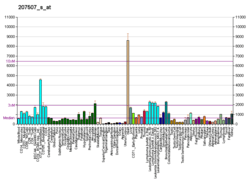ATP5G3
ATP synthase lipid-binding protein, mitochondrial is an enzyme that in humans is encoded by the ATP5G3 gene.[5][6]
This gene encodes a subunit of mitochondrial ATP synthase. Mitochondrial ATP synthase catalyzes ATP synthesis, utilizing an electrochemical gradient of protons across the inner membrane during oxidative phosphorylation. ATP synthase is composed of two linked multi-subunit complexes: the soluble catalytic core, F1, and the membrane-spanning component, Fo, comprising the proton channel. The catalytic portion of mitochondrial ATP synthase consists of 5 different subunits (alpha, beta, gamma, delta, and epsilon) assembled with a stoichiometry of 3 alpha, 3 beta, and a single representative of the other 3. The proton channel seems to have nine subunits (a, b, c, d, e, f, g, F6 and 8). This gene is one of three genes that encode subunit c of the proton channel. Each of the three genes have distinct mitochondrial import sequences but encode the identical mature protein. Alternatively spliced transcript variants encoding the same protein have been identified.[6]
References
- 1 2 3 GRCh38: Ensembl release 89: ENSG00000154518 - Ensembl, May 2017
- 1 2 3 GRCm38: Ensembl release 89: ENSMUSG00000018770 - Ensembl, May 2017
- ↑ "Human PubMed Reference:".
- ↑ "Mouse PubMed Reference:".
- ↑ Yan WL, Lerner TJ, Haines JL, Gusella JF (May 1995). "Sequence analysis and mapping of a novel human mitochondrial ATP synthase subunit 9 cDNA (ATP5G3)". Genomics. 24 (2): 375–7. doi:10.1006/geno.1994.1631. PMID 7698763.
- 1 2 "Entrez Gene: ATP5G3 ATP synthase, H+ transporting, mitochondrial F0 complex, subunit C3 (subunit 9)".
External links
- Human ATP5G3 genome location and ATP5G3 gene details page in the UCSC Genome Browser.
Further reading
- Farrell LB, Nagley P (1987). "Human liver cDNA clones encoding proteolipid subunit 9 of the mitochondrial ATPase complex". Biochem. Biophys. Res. Commun. 144 (3): 1257–64. doi:10.1016/0006-291X(87)91446-X. PMID 2883974.
- Dyer MR, Walker JE (1993). "Sequences of members of the human gene family for the c subunit of mitochondrial ATP synthase". Biochem. J. 293 (1): 51–64. doi:10.1042/bj2930051. PMC 1134319. PMID 8328972.
- Elston T, Wang H, Oster G (1998). "Energy transduction in ATP synthase". Nature. 391 (6666): 510–3. doi:10.1038/35185. PMID 9461222.
- Wang H, Oster G (1998). "Energy transduction in the F1 motor of ATP synthase". Nature. 396 (6708): 279–82. doi:10.1038/24409. PMID 9834036.
- Strausberg RL, Feingold EA, Grouse LH, et al. (2003). "Generation and initial analysis of more than 15,000 full-length human and mouse cDNA sequences". Proc. Natl. Acad. Sci. U.S.A. 99 (26): 16899–903. doi:10.1073/pnas.242603899. PMC 139241. PMID 12477932.
- Lehner B, Semple JI, Brown SE, et al. (2004). "Analysis of a high-throughput yeast two-hybrid system and its use to predict the function of intracellular proteins encoded within the human MHC class III region". Genomics. 83 (1): 153–67. doi:10.1016/S0888-7543(03)00235-0. PMID 14667819.
- Cross RL (2004). "Molecular motors: turning the ATP motor". Nature. 427 (6973): 407–8. doi:10.1038/427407b. PMID 14749816.
- Gerhard DS, Wagner L, Feingold EA, et al. (2004). "The status, quality, and expansion of the NIH full-length cDNA project: the Mammalian Gene Collection (MGC)". Genome Res. 14 (10B): 2121–7. doi:10.1101/gr.2596504. PMC 528928. PMID 15489334.
- Hillier LW, Graves TA, Fulton RS, et al. (2005). "Generation and annotation of the DNA sequences of human chromosomes 2 and 4". Nature. 434 (7034): 724–31. doi:10.1038/nature03466. PMID 15815621.





